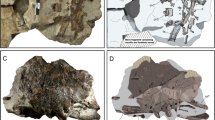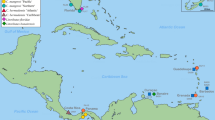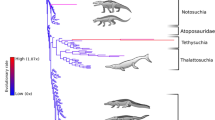Abstract
DIFFERENT species of crocodilians build one of two kinds of nest. For example, the Nile crocodile (Crocodylus niloticus) lays its eggs in a simple hole in the earth, usually sand or loose gravel, which is then covered over with the excavated material to the level of the surrounding ground1–6, whereas the American alligator (Alligator mississippiensis) constructs a mound of vegetation, cleared from the surrounding area, in which it lays its eggs7–13. Schmidt14 suggested that nesting habits might be indicative of relationship, but his idea failed to gain acceptance. One reason for this might be the belief, most recently expressed in an authoritative monograph in 195315, that the differences in nesting habits are not sharp but instead show all possible intermediate stages. In pursuing Schmidt's idea, however, I have reviewed nearly all the literature on crocodilian nesting habits (summarized in Table 1) and conclude that there are absolute differences in these nesting habits and, as I hope to show, these differences are also closely correlated with the evolution and systematics of the group.
This is a preview of subscription content, access via your institution
Access options
Subscribe to this journal
Receive 51 print issues and online access
$199.00 per year
only $3.90 per issue
Buy this article
- Purchase on Springer Link
- Instant access to full article PDF
Prices may be subject to local taxes which are calculated during checkout
Similar content being viewed by others
References
Voeltzkow, A., Zool. Anzeig., 13, 190 (1890).
Voeltzkow, A., Mitt. Sitzungsbericht. König. Preuss. Akad. Wissenschaft., 2, 51 (1891).
Cott, H. B., Trans. Zool. Soc. Lond., 29, 211 (1961).
Pooley, A. C., Lammergeyer, 2, 1 (1962).
Modha, M. L., E. Afr. Wildl. J., 5, 74 (1967).
Pooley, A. C., Lammergeyer, 10, 22 (1969).
Bartram, W., Travels through North and South Carolina, Georgia, East and West Florida …,, 127 (James and Johnson, Philadelphia, 1791).
Feilden, H. W., Zoologist (2), 5, 2090 (1870).
Clarke, S. F., Zool. Anzeig., 11, 568 (1888).
Clarke, S. F., J. Morph., 5, 181 (1891).
Reese, A. M., Smithson. Misc. Collns., 48, 381 (1907).
Svihla, A., Science, 70, 428 (1929).
McIlhenny, E. A., The Alligator's Life History (Christopher, Boston, 1935).
Schmidt, K. P., Field Mus. Nat. Hist. Publ., Zool. Ser., 12, 79 (1924).
Wermuth, H., Mitt. Zool. Mus. Berlin, 29, 375 (1953).
Sill, W. D., Copeia, 76 (1968).
Anderson, A., Proc. Zool. Soc. Lond., 2 (1875).
Willoughby, H. L., Across the Everglades, 73 (Lippincott, Philadelphia, 1898).
Breder, jun., C. M., Bull. Amer. Mus. Nat. Hist., 86, 375 (1946).
Moore, J. C., Copeia, 54 (1953).
Grant, C., Bull. Inst. Jamaica, Sci. Ser., 1, 131 (1940).
Medem, F., Caldasia, 8, 208 (1958).
Worrell, E., Proc. R. Zool. Soc. N.S.W., 1951–1952, 18 (1952).
Waytialingam, S., Proc. Zool. Soc. Lond., 1880, 186 (1880).
Smith, M. A., The Fauna of British India, including Ceylon and Burma. Reptilia and Amphibia. Vol. 1. Loricata and Testudines (Taylor and Francis, London, 1931).
Deraniyagala, P. E. P., The Tetrapod Reptiles of Ceylon, 1: Testudinates and Crocodilians (Colombo Mus., Colombo, 1939).
Varona, L. S., Poeyana, Ser. A, No. 16 (1966).
Schmidt, K. P., Bull. Amer. Mus. Nat. Hist., 39, 385 (1919).
Cansdale, G., Reptiles of West Africa, 87 (Penguin Books, Harmodsworth, Middlesex, 1955).
Witte, G. F. de, Rev. Zool. Afr., 14, 78 (1927).
Neill, W. T., Copeia, 17 (1946).
Sluiter, C. P., Morph. Jb., 20, 75 (1893).
Ogilby, J. D., Proc. R. Soc. Queensland, 18, 201 (1904).
Kopstein, F., Treubia, 11, 306 (1930).
Hagmann, G., Zool. Jb. (Syst.), 24, 313 (1906).
Medem, F., Caldasia, 10, 329 (1969).
Freiberg, M. A., and de Carvalho, A. L., Physis, 25, 357 (1965).
Medem, F., Caldasia, 8, 343 (1960).
Goeldi, E. A., Zool. Jahrb. (Syst.), 10, 653 (1897).
Hagmann, G., Zool. Jb. (Syst.), 16, 405 (1902).
Medem, F., Revta. Acad. Colomb. Cien. Exact. Fis. Nat., 12, 14 (1963).
Medem, F., Fieldiana (Zool.), 39, 227 (1958).
Medem, F., Atlas do Simpósio sôbre a Biota Amazônica, 3, 141 (1967).
Butler, A. L., J. Fed. Malay States Mus., 1, 1 (1905).
Author information
Authors and Affiliations
Rights and permissions
About this article
Cite this article
GREER, A. Evolutionary and Systematic Significance of Crocodilian Nesting Habits. Nature 227, 523–524 (1970). https://doi.org/10.1038/227523a0
Received:
Revised:
Issue Date:
DOI: https://doi.org/10.1038/227523a0
This article is cited by
-
Nest substrate reflects incubation style in extant archosaurs with implications for dinosaur nesting habits
Scientific Reports (2018)
-
Increasing porosity of the incubating alligator eggshell caused by extrinsic microbial degradation
Experientia (1981)
-
Ecological or Phylogenetic Interpretations of Crocodilian Nesting Habits
Nature (1972)
Comments
By submitting a comment you agree to abide by our Terms and Community Guidelines. If you find something abusive or that does not comply with our terms or guidelines please flag it as inappropriate.



